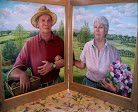It is in my garden and in wild
places that I am most aware of God’s loving presence close to
me, as close to me as my own skin.
When the
weather is kind, I make a pilgrimage several times a day down my garden from the house to a
special place of contemplation, at the bottom of the Lime alley where two
plastic chairs are placed.
 |
| My special place of contemplation at the bottom of the Lime alley |
Let me tell
you a bit about the Lime Alley. It is a double row of large-leafed lime trees (Tilia platyphyllos), chosen because they
do not sucker at the base like the common lime (T. x europaea). We got them from that excellent nurseryman, dendrologist
and Irish Tree Society friend, Jan Ravensberg in Clara, and they were planted as
8-foot whips in 2002 to frame the view of the gates of Kilteelagh House in the
distance.
Fifteen
years later they had grown so well that they were starting to close in over the
Alley and spoil the view, so I arranged for a tree surgeon to reduce them by a
third in every direction in early March this year. I was afraid that the bare
branches would not sprout new growth evenly, but I needn’t have worried as you
can see in this picture, taken looking from the chairs to the house. I notice
that some of the leaves on the new growth are gigantic, at least four times their
usual size – the trees are clearly making up for the loss of so much leaf area.
 |
| The view of the house up the Lime Alley, with the pruned limes resprouting |
The Lime Alley reminds me of the nave of a gothic church, with the soaring trunks as columns. In between the first few trees there are U-shaped hedges of Yew - an awful pun, I know! – like side chapels. As a transept, further down is an elliptical wild-flower meadow, with mown paths through and around it, and twin walnut trees (Juglans
regia) planted at the foci of the eclipse. They were a gift from renowned tree-measurer
Aubrey Fennell, grown from his own nuts, and they first started to bear last
year.
The whole area was a field of barley the year before it was planted, and
is still rather too fertile to make a good wild-flower meadow, but I am
delighted that it is already home to two different native orchids which are spreading: common spotted-orchid
(Dactylorhiza fuchsia ssp fuchsia), and common twayblade (Neottia ovata).
Despite years of cultivation and artificial fertiliser, it still contains the mycorrhizal
fungi required for these orchids to spread.
 |
| The wild-flower meadow like the transept of a church, with a walnut tree in the background |
This is a
place of peace and calm to visit at every time of day and night, whether in the
morning when dew sparkles on the grass and in the spider’s gossamer webs, or on
a sunny afternoon filled with birdsong and the hum of insects, or in the
evening with a glass of wine, or at twilight to sit watching the bats.
Thanks
be to God for it – I merely tend it!

No comments:
Post a Comment